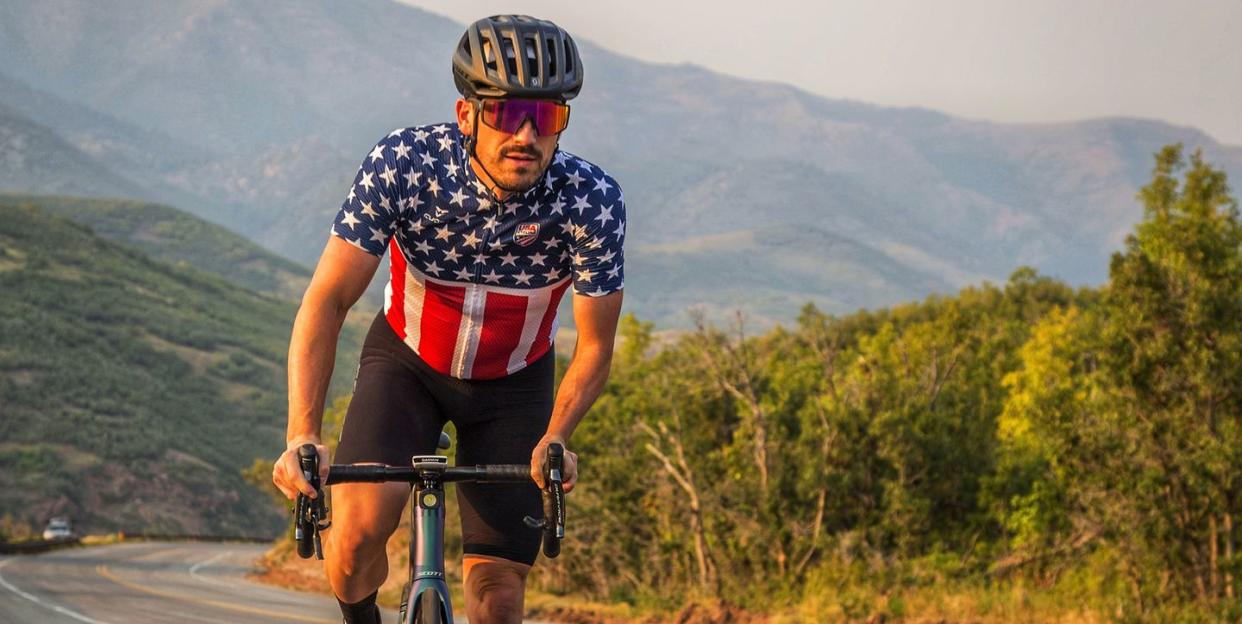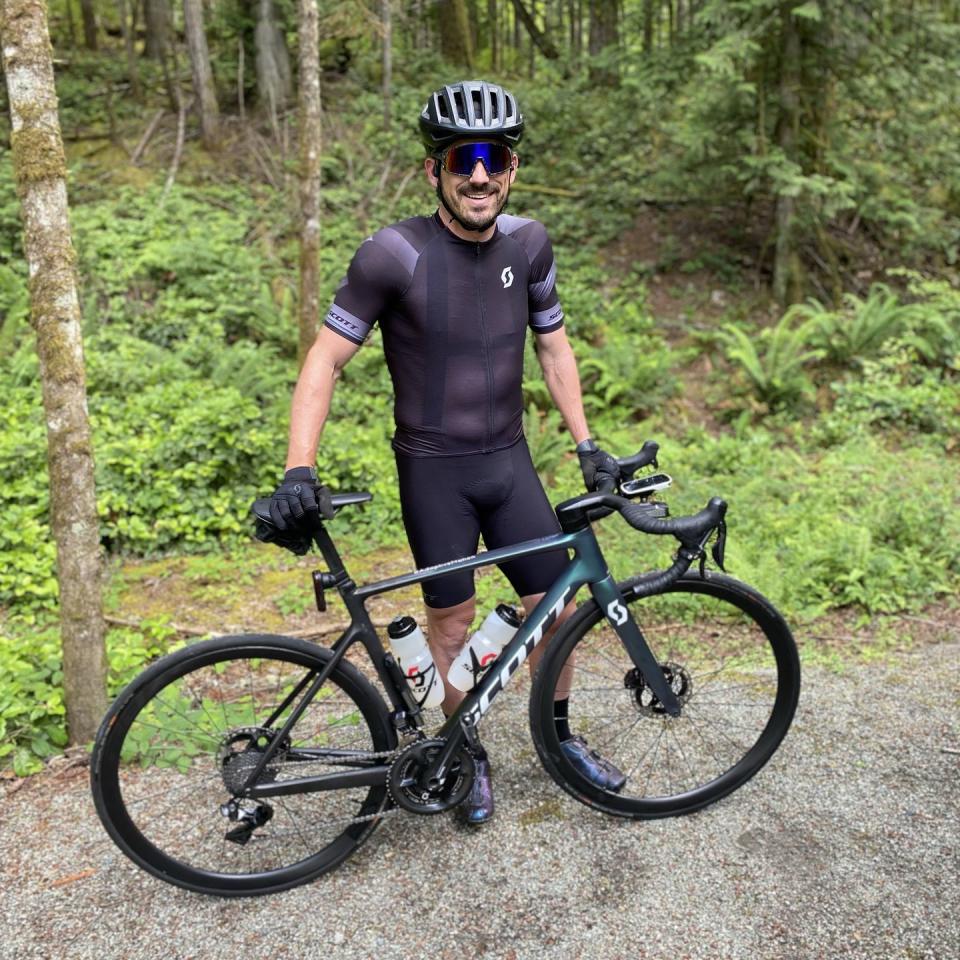This Adaptive Mountain Biker Set the Fastest Known Time Riding the White Rim Trail in One Day

"Hearst Magazines and Yahoo may earn commission or revenue on some items through these links."
Name: Steven Wilke
Age: 39
Hometown: Salt Lake City, Utah
Occupation: graphic designer at Scott sports and volunteer at the National Ability Center
Time Cycling: 21 years
Reason for Cycling: I ride to inspire others with physical disabilities and show them that through cycling, they can do anything. I hope to inspire younger generations with physical disabilities, so they won’t have to overcome mental health struggles.
Growing up with a congenital disability, I always tried to be “normal,” so I hid my limitations. Because the disability affected my left arm, hand, shoulder, and chest, I was able to hide it. However, this caused me stress and anxiety as I was essentially hiding who I really was, which led to feeling depressed over the years. And with no mentors with disabilities, I had to navigate everything on my own.
My disability affects the upper left side of my body, and makes cycling extremely difficult; however, I have learned to put all my bike’s controls on the right side, (I’m unable to shift, brake, and have difficulty holding onto the handlebar with my left hand.) These creative solutions have allowed me to ride, and I’ve helped others copy my design.
I started riding in 2002 when I was a student at Texas A&M University. I realized cycling was the most efficient way to get around campus. Then, I met friends who rode and we started to jump up ledges on our bikes, which led to me riding trials (a form of riding that uses your bike to go over obstacles). What I excelled at with trials was gapping—jumping from one ledge to the next. We soon rode together almost every day. Cycling has the ability to bring people together who would have never met otherwise, and turn them into family.
It wasn’t until 2009 that I started mountain biking, and that is when my love and passion for it ignited. Four years ago, I also got my first road bike. In between all these years and styles of biking, I was slowly modifying my bikes to be able to work for my disability, and I still use some of my same modifications that I came up with way back then. On my road bike, I have two brake levers, and a lot of extra shift buttons to be able to control my ride from the right side. On my mountain bike, I have two brake levers, shifters, a dropper post, and remote suspension controls on the right side.
Throughout my life, I had always volunteered, and kept hearing about the National Ability Center (NAC) in Park City, Utah, so I started volunteering with them in 2018. I felt like I had overcome a lot with mountain biking and my disability, and thought it would be great to volunteer with their mountain biking program and teach others with disabilities how to ride the trails.
After a while there, being around others with disabilities—which is something I never got the chance to do before—I started to feel like myself, without those layers I piled on while trying to hide myself. I became so comfortable that I had a coming-out in December 2018, when I posted on Facebook that I had a disability but had hid it my whole life. That is the moment that my disability became my ability.
Being a part of the NAC led me to get involved in their adaptive cycling film, Tread Setters, which documented cyclists in October 2022 with disabilities riding the 100-mile White Rim Trail in Canyonlands National Park in Utah. The goal was to follow riders as we traversed this revered mountain bike experience.
Later that month I went fully self-supported at White Rim for the FKT (Fastest Known Time), and now hold the FKT for a paracyclist on that trail. I wanted to set a fast time to inspire others with disabilities and their dream to do the White Rim Trail. I don’t want to hold the FKT for long, as I want others to go out and beat my time, and know that they can do anything, and through cycling, that they can overcome the mental and physical aspects of their disability.
This year, I stepped away from the typical paracycling journey (which is going through the Paralympic Committee and USA Cycling, their events and the World Cup races) to help promote and advocate for off-road cycling for para athletes. My goal is to get para mountain biking in the Paralympics, and that is happening one race at a time as my friends and I talk to race directors to add para classes in their events.
Lifetime continues to add para classes to their races, and I have been trying to do all the Lifetime Grand Prix events in hopes of them adding a para class to the Grand Prix to get para off-road cycling on a national stage. So far this year, I won the para class in the Fuego XL race at Sea Otter, and then second place at Unbound Gravel in the 200-mile race. Leadville has a para category this year, and I aim to win it!
Cycling is my life. I work for a bike company, I race, my wife races—my life is bikes all day long. I feel if it wasn’t for cycling, I would be stuck with layers of anxiety piling on. Cycling has freed me, helped me shed those layers, and let the true “me” shine. I have a true purpose in life now: to use cycling as my tool to help others with disabilities avoid the depression and anxiety that I had.
I wish I could say that I am cured of depression, but I am still not where I want to be. With each day of riding, though, I get one step closer to shedding those last layers. And that is why I want to get younger people with disabilities on bikes, so they never have to experience what I did, and to never have that first layer of anxiety and depression form.

These tips have made my cycling journey a success:
1. Use your lunch time to ride
I work for a bike company, and take that to its full advantage by doing a lunch ride every day. Using your lunch time for a ride instead of heading over to the local taqueria for tacos and a beer is one of the best things you could do. Check if your job would be on board with this, as keeping you healthy and happy makes you work more efficiently.
2. Volunteer
For my personal journey, volunteering at the National Ability Center (NAC), has made me who I am now. Getting involved might not sound like a typical tip on cycling success, but without the NAC, I never would have pursued paracycling, and never would have become a national champion. Being around other athletes with disabilities helped me accept my own, which in turn, led me to pursue paracycling at an elite level.
3. Listen to your body
I think training by feel is the best way to train; if you don’t feel like riding that day, don’t. Forcing yourself to ride when you mentally don’t want to seems to make things worse. You know your body better than anyone, so if you feel good that day, do your best to go hard and make the most of your ride, and if your body is tired, take it easy. Eventually, you will figure out what your body needs and you can train effectively and efficiently. Training this way does take more thought and time than using a coach, but if you have the time, it is definitely worth trying.
Steven’s Must-Have Gear
→ TOGS: I can’t live without my TOGS, which are thumb grips designed to increase control and comfort. I have them on my mountain, road, and gravel bikes. Since I can really only control the bike from my right arm, the TOGS give me the extra control I need. They also help my arm with my disability to hold on better. I recommend these to everyone, and once they try them, they are hooked!
→ Garmin Varia Radar: The Garmin Varia Radar is something that I feel keeps me safe while out on the road. I can’t ride without it, I feel it is that valuable to my safety!
→ Halo Skull Cap: I sweat a lot, and the only thing I found to keep the sweat out of my face in the Halo Skull Cap. On those really hot days, I can see without sweat dripping all over my sunglasses.
→ Silca Super Secret Chain Lube: Chain lube might not be something exciting, but I have tried over 30 different lubes, and this lube, by far, is the best I’ve used. My drivetrain is always clean and my chain and drivetrain parts last so much longer now, as wear is greatly reduced.
We want to hear how cycling changed you! Send your story and submit your photos to us via this web form. We’ll pick one each week to highlight on the site.
You Might Also Like

